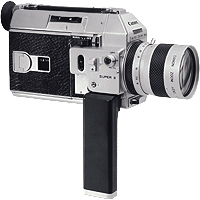 Japan
Japan Americas
Americas Europe, Asia, Oceania
Europe, Asia, Oceania
- Outline
- Specifications
| Marketed | March 1967 |
| Original Price | 71,000 yen |
The Super 8 system had a film pressure plate inside the cartridge, which was unsuitable for high-end cameras. At the beginning, Eastman Kodak did not guarantee a fast lens speed, such as f/1.4. This model was developed to achieve a high-end camera for the Super 8 system. At the beginning, a 6x zoom lens was planned to be attached to this model, but Canon cleared numerous technological hurdles to apply higher magnification with a high-speed zoom lens. These hurdles included a film-driving technology within the allowance of depth of field by a fast f/1.4 lens, focusing and color reproduction for the Super 8 system, which had mainly tungsten films that always required CCA filters during the daytime. Finally, the Auto Zoom 814 Super 8, which had the world first 8x f/1.4 zoom lens, was introduced to the market.
The all metal mechanical design, with a carrying handle on top, in addition to high performance, made this camera very popular among many 8mm movie camera lovers.
| Type | Super 8 type 8mm movie camera | |
| Image Size | 4.2 x 5.7 mm (Projection image size: 4 x 5.4mm) | |
| Film | Super 8 film cartridge | |
| Lens | Focal Length/Speed | 7.5 – 60mm f/1.4 (18 elements in 13 groups, including 6 new type glass elements) Inner diameter: 58 mm, outer diameter: 60 mm Mixed coating of amber, magenta and purple including multi-layer coating |
| Zooming Ratio | 8x | |
| Focusing | Manual (Front lens group rotating method), 1.2 m to infinity | |
| Zooming | Power zooming by high performance micro-motor (Approx. 6 – 9 sec.) Manual zooming with zooming lever with rotation angle of 100 degrees. | |
| Filter Size | 58 mm | |
| Viewfinder | Type | Single-lens reflex type, eyepiece shutter to prevent reverse incoming stray light |
| Rangefinder | Prism screen rangefinder (Micro-prism rangefinder) | |
| Dioptric Adjustment | -3 to +1 diopter | |
| Viewfinder Information | Exposure meter reading window (aperture value, exposure meter needle, over/under exposure warnings and film ending indicator) | |
| Exposure Control | Type | Automatic aperture setting coupled to loaded film speed and shooting speed. Point the subject and the correct exposure is always given. |
| Exposure Meter | Built-in TTL CdS exposure meter | |
| Metering Range | Entire range of ISO 250 f/1.4, 12 fps – ISO 16 f/22, 24 fps | |
| Film Speed | Automatic ISO setting with a cartridge B & W and tungsten type film: ISO 25 – 250 Daylight type color film: ISO 16 – 160 |
|
| CCA Filter | A Color Conversion filter A is built-in to use tungsten type film under daylight. The CCA filter is automatically cancelled with loading of a daylight type film cartridge. Manual cancellation of the CCA filter is possible. | |
| Manual Aperture Setting | Shooting at any manual aperture setting is possible by canceling EE control. Fading in/out is possible by manual aperture setting. | |
| Power Source | Two 1.3 V mercury cells | |
| Battery check | Push button checking | |
| Film Drive | Type | Power filming by a high performance micro-motor |
| Filming Speed | 12, 18, 24 fps and single frame | |
| Power Source | Four AA batteries contained in the grip (Sufficient power for 10 film cartridges under normal temperature) | |
| Footage Counter | Counts up. Automatic resetting by opening the side cover. | |
| Battery check | Push button checking | |
| Shutter | Shutter Opening | 155 degrees |
| Release Sockets | Three sockets for Remote control, single frame and continuous shooting | |
| Switch | Three way switch for off, running lock and remote control | |
| Safety Mechanism | Preventing mistakes on shooting: over/under exposure warning, shutter lock and film drive confirmation Manual cancellation of CCA filter is not possible when a daylight type film is loaded. |
|
| Remote Control | Possible with remote switch | |
| Grip | Holding type, battery compartment for driving AA batteries | |
| Dimensions (W x H x D) | 63 x 107 x 237 mm | |
| Weight | 1,720 g (Body only) | |


